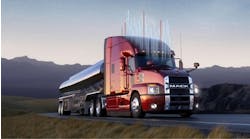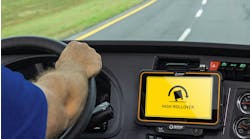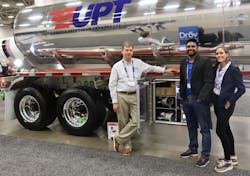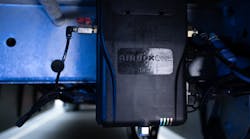The AirBoxOne is no ordinary box.
It’s an advanced electronics and pneumatics control platform with virtually unlimited connectivity, expandability, and functionality that transforms an ordinary trailer into a smarter, safer, more efficient commercial vehicle—aka the Drōv Smart Tanker Powered by AirBoxOne.
Think of it as a Rosetta Stone for digital languages, or the Swiss Army Knife of transportation communications tools.
It’s also the inspired culmination of many years of development, the lessons learned through its creator’s past failures, and the input of multiple fleets, trailer manufacturers, and component suppliers, who informed Drōv Technologies of their needs and abilities—all combined into a singular system afforded extra time to incubate during a global pandemic.
“It provides powerful insights,” said Tim Gallagher, vice president of maintenance and facilities for United Petroleum Transports (UPT), Drōv’s key test partner in the tank truck segment. “It takes a basic trailer and turns it into a smart system.
“There are a lot of technologies out there, but nothing else that I’ve seen that brings everything together into one system, which you can continue to add onto by going through their portal and tying it all together.”
Innovation creation
The Oklahoma City-based company that makes the AirBoxOne started out as a tire management systems manufacturer but pivoted to smart trailers and rebranded as Drōv Technologies in 2016, with the goal of establishing itself as a transportation technology innovator, while still leveraging its inherited expertise.
But before disrupting an industry, Drōv leaders had to draft the right, forward-thinking experts.
Chief technology officer Pete Jankowski, the “father” of the AirBoxOne, joined the group in 2016 to spearhead development of Drōv’s electronic control system. Adwait Kulkarni, the senior automotive engineer behind the trailer system’s installation, joined in 2017; and fleet liaison Bob Davis, a longtime UPS transportation director, was lured out of retirement in 2018, and named vice president of business enterprise last year.
Drōv now has a team headquartered in Oklahoma, a light assembly operation in Minnesota, and an offshore software/hardware partner in India.
“That was one of my focuses coming in,” said Lisa Mullen, a managing partner who became the CEO in March 2020—just as COVID-19 reached the United States. “I knew we had to grow the team, and we had to do it the right way. We weren’t necessarily successful with hiring the right people early on, which often is challenging with a startup, because there’s less you can offer, a lot of work, and a lot of hats to wear. But we’ve hired great people since then. I frequently get complements from fleets and manufacturers on the quality of people working for us. So I’m very proud of the team we’ve put together.”
Jankowski, a self-professed serial entrepreneur, started and sold two security companies that specialized in advanced video surveillance and card-access systems before joining Drōv. His introduction to transportation was designing and equipping theft-detection systems on “sting” trailers for Target Corporation.
He also worked on two projects that fell short because they skimped on power.
On one, a development initiative with Sony, a lack of CPU capacity forced him to spend an extra year coding, and ultimately caused the product to miss the market, he said. On another, he spec’d a system with the requested number of camera inputs, which his partners later decided they wanted to double, but he couldn’t because the hardware he’d already built and tested didn’t have the requisite “horsepower.”
In both cases, he lamented, a few extra dollars in parts up front could have forestalled his equipment constraints.
That’s why Mullen says Jankowski “over-engineered” the AirBoxOne by outfitting it with all the technology needed today—and everything fleets might need in the future.
“Both of those products worked extremely well,” Jankowski said. “But if I would have had a little bit more head room, I could have done a lot more. So that’s the approach I took here. I don’t know what I don’t know, and we may need something else. And the chips I’m using have all the interfaces on them, so I said, ‘Why not expose them?’ Worst case, I have to remove an ethernet connection, or depopulate a radio chip. Those are easy fixes. I just take it off. But if it’s not there at all, and you want to add something, you have to redesign everything.”
After several years of design and development, Drōv was ready to enter commercialization last year. Then the pandemic hit, and many fleets and OEMs closed their doors to outsiders, delaying the systems’ debut by six to eight months, Davis estimated. But the setback also presented them with an opportunity to enhance the AirBoxOne’s capabilities by using the extra time to “dig deeper into its feature set,” Mullen added.
The freshly reinforced AirBoxOne, now in its fourth iteration, finally debuted on a dry van trailer in September at American Trucking Associations’ Technology and Maintenance Council (TMC) Fall Meeting in Cleveland.
It was introduced to bulk haulers during National Tank Truck Carriers’ Tank Truck Week in October in Dallas.
“It’s exciting,” Mullen said. “Unfortunately, our (TMC) debut came on the heels of COVID, so the attendance probably wasn’t what we would have liked. But it was great to finally have a trailer there, so people could see what we’re doing.
“And the system’s vehicle health display, a communication tool that sits on the nose of the trailer—or on the side of the tank trailer—is something that we really developed during COVID, due to our partners asking for such a device, and that got so much attention at TMC, and during Tank Truck Week. So it is interesting for us to see what pulls people in, and gets them interested, and now, what the follow-through will be.”
‘Pure’ partnership
Drōv has been testing its AirBoxOne on dry van trailers since November 2018. It began testing the system with UPT after CEO Greg Price attended a Drōv technology council meeting early this year, and insisted they fully trick out a new LBT trailer for Tank Truck Week.
“We’ve got great partners who really push us every week,” Davis said. “We wouldn’t be here today, and this far along, if it wasn’t for these fleets pushing us for solutions on the smart side. So those partnerships are very important.”
Technology council meetings also include key OEMs and suppliers, like Grote Industries, Haldex, HDNABI, SAF-Holland, and SKF, who helped Drōv refine the AirBoxOne, and deliver comprehensive “smart” integrations that benefit fleets in exponential ways. “We’re able to bring together all of these smart components onto a unified platform,” Mullen said. “Because Pete built it out in such an open way, with so many communication capabilities, it is easy for us to integrate with other smart partners, or develop our own solutions.”
The system’s side cameras were added at UPT’s behest. Now users can see what’s behind the trailer, through rear cameras with 190-degree views, and access high-definition video of adjacent lanes going down the road, for liability issues, and of loading/unloading activities on location, for safety and training purposes.
Gallagher said he most appreciates the system’s health display, which makes pre- and post-trip inspections easier for drivers, and its granular tire management—bolstered by the company’s history in making wheel end rotary union hardware—which aids in their efforts to maintain tires with proper inflation that is electronically adjustable based on trailer weight; and offers fleets real-time tire monitoring and alerts.
“It’s a Lego-style approach to trailer technology,” Gallagher said.
“So you can have the minimum, or add as much as you want, like we did, from the tire monitoring system, and inflation/deflation, to warnings, and even hub temperatures, so we can monitor what our wheel-end temperatures are. We can also monitor brake-chamber pressure, rotor and brake-pad thickness, see if the trailer brake is set, and when it goes through its pre-trip check. If any light is out on that trailer, it’s going to give us a warning. And we have the cameras—backup and side cameras, and (ultrasonic) backup sensors.”
The AirBoxOne also promotes efficiency with trailer weight monitoring. Axle sensors measure gross vehicle weights, before and after loading, and new Bluetooth sensors epoxy-mounted on the belly of the trailer read fluid levels in each compartment, allowing bulk haulers to legally maximize weight limits, or detect retain.
UPT is testing two trailers in real-world situations: The new, fully spec’d LBT; and a retrofitted 14-year-old Polar tank trailer, minus the cameras.
Drōv also now is working with Oklahoma City-based Gemini Motor Transport, the primary carrier for Love’s Travel Stops, and talking to two other, well-known tanker fleets about forming partnerships.
“We intentionally haven’t spread ourselves thin with test partners, because we’re going deep with the partners we have,” Mullen said. “And in both the dry van and tanker worlds, those partners have really informed us what features are important, how we should deliver on them, and how we support them in the field. So these partnerships are pure collaborations that allow us to hear the true voice of the customer.”
Universal connectivity
The AirBoxOne’s greatest utility is in its universal gateway functionality, which unites myriad smart components through an IoT board designed with open-standard, agnostic architecture that lets today’s technologies work together, and “future-proofs” the system by enabling new expansions and applications.
The cloud-enabled control box, installed underneath the trailer chassis, boasts seven wireless connections, including multiple cellular options; GPS for location and speed; WiFi for mobile devices; Bluetooth for pairing with the tractor, various sensors, and electronic door locks; Zigbee for monitoring reefer temperatures, sub-GHz networking for tire pressure monitoring, and LoRa radio for waking up trailers in the yard.
Wired connections include dual CAN interfaces, power-line communications, analog-to-digital converters, ethernet, USB, and general-purpose input/output (GPIO) ports that allow for limitless configurations. “All these interfaces come in handy because you never know what you’re going to hook up to,” Jankowski said.
AirBoxOne connections also are interchangeable, Jankowski explained. For instance, if 4G cellular technology goes away, as is happening to 3G now, fleets can simply pop off the 4G module and replace it with a 5G component, and avoid scrapping the whole system. Expandable SD card storage furthers futureproofing.
In addition to the trailer-mounted health display, the system features an in-cab driver interface, and a web-based fleet interface.
Jankowski’s also working with several telematics provides to integrate web-based analytics.
“You can add anything to the AirBoxOne,” Davis said.
“There’s so much technology out there, but each one has its own system, or setup. With this, it’s one system, one solution.”
Unordinary intelligence
It’s also one endless supply of possibilities.
By capturing and transmitting multi-point operational data, the system improves predictive maintenance, and performs diagnostics in advance, making technicians more efficient, and trailers safer and more reliable. Vibration sensors can detect loose lug nuts before the wheels come off, leaving drivers stranded.
Throw in ABS warnings; an accelerometer that monitors for hard braking, trailer ride quality, and extreme g-forces; and cargo security—Jankowski said one Chicago-area fuel supplier suspected a driver was topping off friends’ tanks—and the list goes on and on, with potential payback limited only by fleets’ imagination.
But to realize the full ROI, fleets need the system on every trailer, Davis argued. The good news, especially for mixed fleets, is Drōv makes systems for most trailer types, including dry vans and reefers, and now tankers and flatbeds. “There are only a few companies out there that can cross the line between asset types,” Mullen said.
And while Jankowski’s happy to add capabilities daily, including, at some point, a monitoring service, she’s focused on honing what they already do best. “The goal is to continue to introduce our technology to manufacturers through our customers, and continue to support our test partners,” she said. “We anticipate retrofits will be an important part of our strategy next year, given the capacity at most manufacturers.”
Gallagher said UPT will continue testing the systems over the next several months, to see how components hold up over time. But given the benefits its already provided—including helping drivers navigate tight gas station parking lots—he could see UPT moving forward with a scaled-up deployment in 2022.
“We had so many people at (Tank Truck Week) walking around and saying, ‘Wow, I would really like to have that camera over the loading area,’ or ‘Hey, look at that backup camera,’” Gallagher said. “So I can definitely say, just from a safety perspective with the cameras, other bulk carriers should consider utilizing this technology.”
Because, as UPT and now TTW attendees know, the AirBoxOne is one unordinary box.
“There are a lot of fleets still waiting on the sidelines, but I think the tanker market is a little bit different,” Mullen said. “They’re eager for technology, and they’re underserved in many ways, so it’s been a nice transition into a market that probably is a little bit more receptive, and has the capability to put it on now.”











